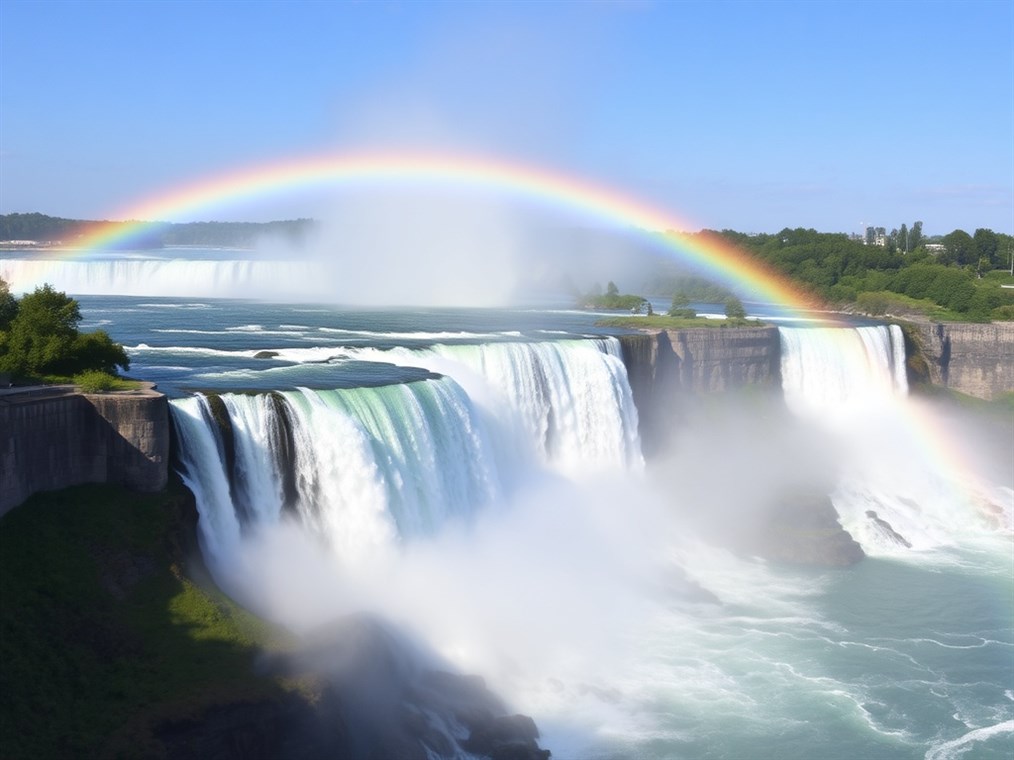
Niagara Falls: How Quickly is This Natural Wonder Really Changing?
FactsNiagara Falls: How Quickly is This Natural Wonder Really Changing?
Niagara Falls. Just the name conjures up images of thundering water and misty rainbows, right? It’s a truly majestic sight, straddling the border between Canada and the US, and a testament to the raw power of nature. But did you ever stop to wonder if this iconic landmark is, well, disappearing? The truth is, Niagara Falls is constantly changing, slowly carving its way upstream thanks to the relentless Niagara River. The real question is: how fast is this happening?
A River Runs Through… Time
Okay, so Niagara Falls didn’t just pop up overnight. Its story began way back, around 12,500 years ago. Picture this: the falls were originally located near what we now know as Queenston, Ontario, and Lewiston, New York. Since then, it’s been on a slow march southward, chewing its way through the landscape and creating the dramatic Niagara Gorge. Back in the day, we’re talking a pretty rapid retreat – about 3 to 6 feet every year. Can you imagine? That’s a noticeable shift every few decades! Over those 12,300 years, it’s estimated that Niagara Falls has eroded a whopping 7.1 miles. That’s some serious geological hustle.
Hold on, It’s Slowing Down!
Now, here’s the interesting part. The erosion isn’t nearly as dramatic as it used to be. In fact, it’s slowed to a crawl. These days, we’re talking about a foot a year, maybe even a foot every ten years! What gives? Well, we humans have had a hand in it.
Think of it this way: we’ve basically put the brakes on Mother Nature. How? A few key things:
- Water Diversion: There’s a treaty between Canada and the US that allows us to divert water from the Niagara River for hydroelectric power. Less water going over the falls means less erosion, especially when demand for power is low. They’re diverting a lot of water – up to 50,000 cubic feet per second!
- Rock Solid (Literally): Engineers have been working hard to reinforce the cliffs and prevent those dramatic collapses. They’ve even built underwater weirs to redirect the strongest currents.
- Tough as Nails: The water’s currently flowing over a layer of limestone, which is much tougher than the rock it used to erode. Think of it like trying to carve through granite versus sandstone. Big difference!
So, What’s the Long-Term Forecast?
Even at this slower pace, Niagara Falls will keep changing. Scientists reckon that at the current rate, it’ll take somewhere between 20,000 and 50,000 years to erode the remaining 20 miles to Lake Erie. And then? Well, the falls would likely cease to exist, turning into a series of rapids. A bit of a sad thought, isn’t it?
Of course, that’s just an estimate. Climate change could bring drier conditions, slowing things down even further. On the flip side, a major rockfall could speed things up again. And the shape of the falls matters too. A V-notch shape concentrates the water’s force, leading to faster erosion. That’s why the International Niagara Board of Control keeps a close eye on the Horseshoe Falls crest line.
Human Intervention: Help or Hindrance?
Here’s where it gets a bit philosophical. While diverting water and reinforcing rocks has slowed erosion, it’s also fundamentally changed the natural processes at Niagara Falls. Some argue that it’s now “a completely man-made and artificial cataract.” Back in 1969, they even stopped the water flow over the American Falls to study the geology. Imagine seeing it dry! While they ultimately left the fallen rocks in place, it sparked a big debate about how much we should interfere with nature. It’s a tough question, isn’t it?
A Legacy Worth Protecting
Regardless of what the future holds, Niagara Falls is a natural wonder that deserves our respect and protection. Millions flock to see its beauty every year, and it’s our responsibility to ensure that future generations can experience the same awe. Whether that means continued intervention or a more hands-off approach, we need to find a balance between preserving this iconic landmark and letting nature take its course. After all, it’s a story that’s been unfolding for thousands of years, and we’re just a small part of it.
You may also like
Disclaimer
Categories
- Climate & Climate Zones
- Data & Analysis
- Earth Science
- Energy & Resources
- Facts
- General Knowledge & Education
- Geology & Landform
- Hiking & Activities
- Historical Aspects
- Human Impact
- Modeling & Prediction
- Natural Environments
- Outdoor Gear
- Polar & Ice Regions
- Regional Specifics
- Review
- Safety & Hazards
- Software & Programming
- Space & Navigation
- Storage
- Water Bodies
- Weather & Forecasts
- Wildlife & Biology
New Posts
- Diving Deep into Tangerine: More Than Just a Sunny Locale
- Jamaica Backpack Daypack Pockets Shopping – Review
- TEOYETTSF Climbing Backpack Multifunction Military – Buying Guide
- The Curious Case of Cavendish’s Classroom: Where Did This Science Star Study?
- Dragon Backpack Insulated Shoulder Daypack – Buying Guide
- ROCKY Hi-Wire Western Boots: A Rugged Review After a Month on the Ranch
- Vertical Curbs: More Than Just Concrete Barriers
- Regatta Modern Mens Amble Boots – Honest Review
- YMGSCC Microfiber Leather Sandals: Beach to Boardwalk, Did They Hold Up?
- Tangier: More Than Just a Backdrop in “Tangerine”
- DJUETRUI Water Shoes: Dive In or Doggy Paddle? A Hands-On Review
- Barefoot Yellow Pattern Hiking 12women – Is It Worth Buying?
- Koa Trees: How Fast Do These Hawaiian Giants Really Grow?
- DDTKLSNV Bucket Hat: Is This Packable Sun Shield Worth the Hype?